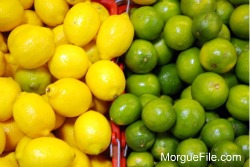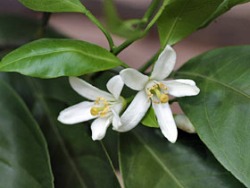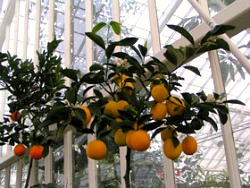
Lemons and limes make great edible landscape trees for small yards in warm climates and are adapted to growing in containers in colder climates.

Lemon and lime flowers are sweetly scented and bloom in winter, making them perfect for indoor growing and enjoyment.
Winter is citrus time in much of the country. Whether you're eating citrus shipped from warmer climates or lucky enough to live in a climate where you can grow citrus yourself, now is the time to enjoy these luscious fruits.
While oranges and grapefruits get most of the citrus attention, lemons and limes shouldn't be discounted. They're an easy to grow citrus that's perfectly suited to a small space edible garden. Lemons and limes can be grown in the ground in warm climates or in large containers in warm or cool climates. Even gardeners in cold winter areas can enjoy these evergreen trees if they have a sunny space in which to winter them over indoors.
You can select trees that will produce an abundance of fruits for years without needing a pollinator. I remember visiting friends in California and being amazed at how the lemon and lime fruits were so abundant on the trees that many fell to the ground and rotted before they could be eaten.
So plan on growing a lemon or lime outdoors if you live in a USDA zone 9 or warmer climate. In colder areas plant one in a container to bring indoors. Even if you don't have the perfect spot for it in winter and it doesn't fruit, chances are it will at least flower, and the scent will perfume the whole house.
PlanningLemons (Citrus limon) and limes (Citrus aurantifolia) need full sun and warm temperatures to grow their best. While many types of citrus varieties are adapted either to the high humidity of Florida and the Gulf Coast or the low humidity of the Southwest, lemons and limes can thrive in either climate. However, lemons and limes are more sensitive to cold than other kinds of citrus and shouldn't be allowed to be touched by frost. They actually stop growing when temperatures dip below 50 F. The trees are in a semi-constant state of growth all season long. That's why you'll see a tree with flowers, young fruit, and mature fruit hanging on the plant at the same time. This is an advantage for gardeners since it extends the fruiting season for months. You can grow lemons and limes from seed collected from store-bought fruit, but although a fun home project with kids, the trees will take longer to flower and the quality of the fruit may not be very good. Stick with buying a nursery-grown variety instead.
While 'Meyer' lemon and 'Bearss' lime are perhaps the most widely known lemon and lime varieties, there are other varieties available for the adventurous gardener. Here's a rundown of some of the best.
'Bearss' lime- Also known as the Tahitian lime or Persian lime, this is the most widely grown lime variety for home gardeners and one usually found in grocery stores. It grows to 20 feet tall and wide producing 3-inch diameter, seedless fruits with a strong lime flavor.
'Eureka' lemon- Considered a true lemon, it was brought to the United States by Christopher Columbus, but originally hailed from India. It's the most popular commercial lemon variety available. 'Eureka' is widely grown on the West coast, producing 20 feet tall, bushy trees that are mostly thornless. 'Lisbon' is another similar true lemon variety that is more resistant to cold weather. There is also a variegated 'Eureka' variety available.
'Kaffir' lime (Citrus hystix)- This bushy tree can reach 20 feet tall, but is easily kept pruned to under 10 feet tall. It is known as much for its aromatic leaves, which are essential for Southeast Asian cooking, as its small, juicy fruits. When I lived in Thailand, almost every home in the village had a 'Kaffir' lime tree for use in cooking, hair washing, and cleaning laundry.
'Mexican' lime'- Also known as the key lime or West Indian lime, this small bushy tree grows up 15 feet tall and produces 2-inch diameter fruits with a strong acidic lime flavor. There are thornless versions as well.

'Meyer' lemon is the most popular and widely known lemon variety and makes a great container plant.

Lemon and lime trees make great indoor houseplants, and you don't need a conservatory to grow them. A sunny south facing window will do.
'Meyer' lemon- Although not a true lemon, 'Meyer' lemon has become the most widely recognized lemon available for home gardeners to grow. The fruits don't have as strong a lemon flavor as true lemons and the fruits resemble an orange. However, the thornless, small bush only grows to about 10 feet tall (smaller in a container), is more cold tolerant than true lemons, and the flavor less acidic. Look for the 'Improved Meyer' lemon when buying this variety. 'Improved Meyer' has been certified disease-free, and it's the best lemon for indoor growing since the trees are naturally dwarf.
'Palestinian' sweet lime (Citrus limettioides) - This round-shaped fruit doesn't have the strong flavor of 'Bears' lime, but the juicy fruits offer a milder taste that's perfect for making limeade. The plant grows into a large shrubby bush.
'Ponderosa' lemon- 'Ponderosa' lemon is a citron-lemon hybrid. The tree produces a 10- to 20-foot tall, rangy, thorny tree that has large, grapefruit-sized fruits with a strong lemon flavor.
PreparationLemons and limes love plenty of sunshine and moist, well-drained soil. They don't grow well in heavy clay soils or in any location where their roots will sit in water. In marginally hardy areas, consider planting lemon and lime trees against a south-facing wall, building, or fence to create a micro-climate to protect them from cold winter weather.
PlantingPlant lemon and lime trees in spring once the weather warms. Although lemons and limes are known for their acidic fruits, the plant itself actually likes a more neutral pH; sweeten the soil with lime if needed. Amend the soil with compost, and plant trees 15- to 25-feet apart, depending on the variety. Dwarf and bush varieties can be planted 8- to 12-feet apart.
For container growing, select a large (15 gallon or half whiskey barrel size) pot, making sure it has drainage holes in the bottom. Fill the pot with moistened potting soil. Keep the container well watered.
CareThe key to developing a healthy lemon or lime tree is watering. Although lemons and limes don't like wet soil, they do require a constant supply of moisture to grow their best. Keep soils moist with drip irrigation or soaker hoses, and mulch. Fertilize in-ground trees 2 to 3 times from spring until summer with a citrus fertilizer. Container trees require monthly fertilization until midsummer.
Prune out suckers that develop along the tree trunk anytime, and thin any spindly branches in late winter after the main fruit harvest. Especially with lemons, prune to create strong scaffold structure of branches that can hold up the heavy fruits. Thin lemon and lime fruits to about 4- to 6-inches apart when they're small if you want fewer, but larger fruits to eat.
Watch out for pests such as aphids and scale on lemon and lime leaves. Aphids love to attack new growth. Spray them with insecticidal soap. Scale insects can be found on the underside of leaves, where their feeding creates a sticky, honeydew secretion that supports the growth of sooty mold. Spray horticultural oil to control scale insects.
In areas with frost, bring container-grown lemons and limes indoors when outdoor temperatures drop to 40 F. Keep trees in a sunny window, reduce watering, and watch for pests.
HarvestYour lemon and lime trees should start producing fruit when they are about three years old. Most fruits mature about four months after blooming. Pick lemons when the skin color is completely yellow, but before the skin wrinkles. Wrinkly skin is a sign the fruits are over-mature.
Limes are actually picked when they're still immature and green for best flavor. If allowed to ripen, lime fruits turn yellow like lemons. Harvest about three to four months after flowering when the lime skins have a light green color, are smooth textured, and slightly soft when squeezed. Cut open a few fruits; if they are juicy inside, it's time to pick.
More articles on lemons and limes:Grow Citrus in a Container
Plant Citrus Trees
Citrus
Growing Citrus
 Charlie Nardozzi is an award winning, nationally recognized garden writer, speaker, radio, and television personality. He has worked for more than 30 years bringing expert gardening information to home gardeners through radio, television, talks, tours, on-line, and the printed page. Charlie delights in making gardening information simple, easy, fun and accessible to everyone. He's the author of 6 books, has three radio shows in New England and a TV show. He leads Garden Tours around the world and consults with organizations and companies about gardening programs. See more about him at Gardening With Charlie.
Charlie Nardozzi is an award winning, nationally recognized garden writer, speaker, radio, and television personality. He has worked for more than 30 years bringing expert gardening information to home gardeners through radio, television, talks, tours, on-line, and the printed page. Charlie delights in making gardening information simple, easy, fun and accessible to everyone. He's the author of 6 books, has three radio shows in New England and a TV show. He leads Garden Tours around the world and consults with organizations and companies about gardening programs. See more about him at Gardening With Charlie.
 Victory Seed Company has all the seeds you want for your best garden in 2024.
Victory Seed Company has all the seeds you want for your best garden in 2024.
For 25 years, the family-owned Victory Seed Company has provided the highest quality vegetable, herb and flower seeds to families across the country. We are passionate about providing you the best seeds available that give excellent germination, robust plants, and the harvest you want. With a catalog of over a thousand varieties, we have everything, and our prices are the kinds that we'd want to pay. We have hundreds of yesterday's heirloom vegetables, as well as today's award winning hybrid selections. Get to know us by visiting our website and browsing through our online vegetable seed catalog.